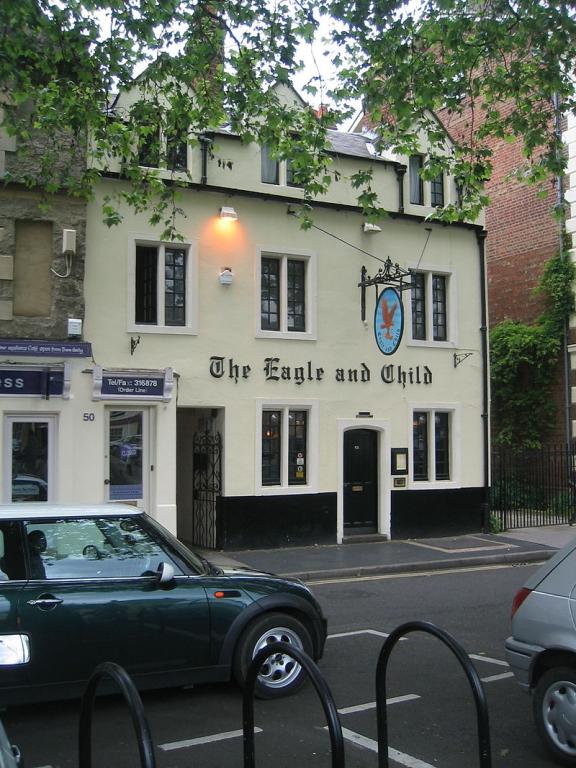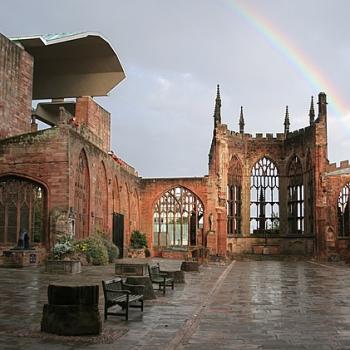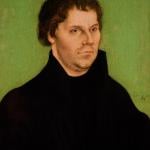
We’re lodging not terribly far from Stonyhurst College, a residential school (formerly for boys only, but now coeducational) that has been ranked as the foremost Jesuit prep school in the English-speaking world and described as “Eton for Catholics.” We drove by it early this evening after dinner.
The Jesuit poet Gerard Manley Hopkins taught classics at Stonyhurst, and his poems are said to feature details drawn from the local countryside. Given the idyllic beauty of this area, it would not surprise me in the least to learn that his famous poem “God’s Grandeur” was inspired by his surroundings at Stonyhurst:
The world is charged with the grandeur of God.It will flame out, like shining from shook foil;It gathers to a greatness, like the ooze of oilCrushed. Why do men then now not reck his rod?Generations have trod, have trod, have trod;And all is seared with trade; bleared, smeared with toil;And wears man’s smudge and shares man’s smell: the soilIs bare now, nor can foot feel, being shod.And for all this, nature is never spent;There lives the dearest freshness deep down things;And though the last lights off the black West wentOh, morning, at the brown brink eastward, springs —Because the Holy Ghost over the bentWorld broods with warm breast and with ah! bright wings.
Sir Arthur Conan Doyle, the creator of Sherlock Holmes, was a student at Stonyhurst. Some have suggested that “Baskerville Hall,” in his 1902 novel The Hound of the Baskervilles, was modeled on Stonyhurst Hall. John Moriarty was a classmate of Conan Doyle’s at Stonyhurst who went on to be appointed Solicitor-General for Ireland, then Attorney-General for Ireland, and finally a Lord Justice of the Court of Appeal in Ireland. But he may be most famous for having lent his surname to Sherlock Holmes’s archnemesis, the criminal mastermind known as Professor James Moriarty.
Christopher Tolkien taught classics at Stonyhurst, and his father, J. R. R. Tolkien, wrote a portion of The Lord of the Rings during a stay at the college while visiting Christopher. At least a couple of elements of Middle-earth appear to have been based upon the local area, including “Shire Lane” (which is the name of a road in Hurst Green) and “the River Shirebourn” (which seems to be named after the Shireburn family, who founded and built Stonyhurst.
And then, after returning to our hotel this evening, I came across this sobering article: “Thinking about C.S. Lewis and today’s emerging prophets of transhumanism.” It even has a Latter-day Saint connection, though a sadly rather tenuous one.

(Wikimedia Commons public domain photograph)
I’ve made the pilgrimage there several times. And the food’s not bad, either.
So now I’m in a Tolkien-and-Lewis mood. And I’m also fairly tired after a pretty long day. So, because I still have promises to keep and several miles to go before I sleep, I’m going to share with you a column that I wrote eleven years ago:
During a rambling, all-night discussion in the late 1960s, a famous Nobel laureate physicist told a group of Caltech students and their friends (among the latter a high school girlfriend of mine) that, though he loved C.S. Lewis’ science fiction novels, he hated the “religious propaganda” that Lewis tacked on to them.
But surely Mr. Richard Feynman was wrong. The religious themes of C.S. Lewis’ stories are far from “tacked on.” They’re central to his fiction, as they are to virtually everything he wrote. At first, Lewis’ conversion to Christianity following years of atheism could scarcely be described as enthusiastic: “In the Trinity Term of 1929,” he later wrote of his student days at Oxford University, “I gave in, and admitted that God was God, and knelt and prayed: perhaps, that night, the most dejected and reluctant convert in all England.” His reluctance soon left him, however, and he became, as William F. Buckley once described him, the most convinced and convincing Christian writer of his generation.
While building a distinguished scholarly career in medieval and Renaissance English literature, first at Oxford and later at Cambridge, Lewis also managed to pour out a stream of essays, novels and theological works that sold widely and brought him a legion of admirers throughout the English-speaking world. He was at the center of a small rebellion in British university life during the 1930s and beyond. With his friends Charles Williams, Dorothy Sayers and J.R.R. Tolkien, he was a committed Christian author at a time when religion in general and Christianity in particular enjoyed (to put it mildly) little prestige among intellectuals.
C.S. Lewis’ too-early death on Nov. 22, 1963, was obscured by the assassination of John F. Kennedy on that same day. (It was also the day on which the novelist Aldous Huxley died.) But Lewis’ fame and popularity have continued to soar. His books not only sell but are turned into movies.
Why does he remain so popular? There are many reasons. He was, for one thing, a brilliant writer. He’s fun to read, endlessly quotable, with a good sense of humor and a marvelous gift for storytelling. His imagination was rich and well-stocked with vast learning, which he managed to wear quite lightly, indeed effortlessly. Importantly, he didn’t disdain writing for ordinary people. In fact, he once proposed that every divinity student at Oxford should be required to explain sophisticated theological doctrines to Royal Air Force mechanics before taking a degree. These were intelligent men, Lewis reasoned, but not intellectuals and not very patient with jargon. If the student couldn’t explain a difficult concept to them, it was because he didn’t understand it himself.
Lewis is approachable because, although he was a powerful thinker, he wrote about everyday realities of human behavior, of prayer and moral struggle, rather than about bloodless abstractions. He saw those realities for what religious people have generally claimed them to be: the arena in which eternally significant choices are made, the field of battle between the divine and the diabolical. There’s far more human insight in his famous Screwtape Letters or in the less well-known but brilliant Till We Have Faces than in many a ponderous volume of supposedly scientific psychology.
Christians who lament the low state of the culture around them, who fear its moral effect on their children, could do far worse than to read aloud to their children from Lewis’ rich, Christ-centered Chronicles of Narnia. They would do well to take a few hours away from television or the latest hit film to enter into the excitement of his Perelandra trilogy and, along the way, to ponder its profound treatment of redemptive suffering, temptation and the reality of evil.
Once, explaining why bowing or kneeling in prayer really matters, Lewis commented that it was necessary for the body to pray, as well as the spirit. In a similar way, one might say that, for us to be truly converted spiritually, our imaginations must be baptized, and not merely our bodies or even our minds. C.S. Lewis — as much, perhaps, as any modern writer in any theological tradition — had the ability to make his readers feel religiously, as well as to lead them to think about religion. His writings feed the mind, but they also nourish the heart. Few writers have been so successful in accomplishing that.
Posted from Chipping, Preston, Lancashire, England












